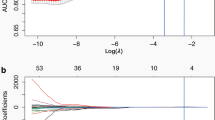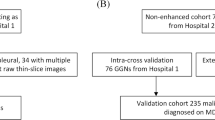Abstract
Objectives
To develop a model for differentiating the predominant subtype-based prognostic groups of lung adenocarcinoma using CT radiomic features, and to validate its performance in comparison with radiologists’ assessments.
Methods
A total of 993 patients presenting with invasive lung adenocarcinoma between March 2010 and June 2016 were identified. Predominant histologic subtypes were categorized into three groups according to their prognosis (group 0: lepidic; group 1: acinar/papillary; group 2: solid/micropapillary). Seven hundred eighteen radiomic features were extracted from segmented lung cancers on contrast-enhanced CT. A model-development set was formed from the images of 893 patients, while 100 image sets were reserved for testing. A least absolute shrinkage and selection operator method was used for feature selection. Performance of the radiomic model was evaluated using receiver operating characteristic curve analysis, and accuracy on the test set was compared with that of three radiologists with varying experiences (6, 7, and 19 years in chest CT).
Results
Our model differentiated the three groups with areas under the curve (AUCs) of 0.892 and 0.895 on the development and test sets, respectively. In pairwise discrimination, the AUC was highest for group 0 vs. 2 (0.984). The accuracy of the model on the test set was higher than the averaged accuracy of the three radiologists without statistical significance (73.0% vs. 61.7%, p = 0.059). For group 2, the model achieved higher PPV than the observers (85.7% vs. 35.0–48.4%).
Conclusions
Predominant subtype-based prognostic groups of lung adenocarcinoma were classified by a CT-based radiomic model with comparable performance to radiologists.
Key Points
• A CT-based radiomic model differentiated three prognosis-based subtype groups of lung adenocarcinoma with areas under the curve (AUCs) of 0.892 and 0.895 on development and test sets, respectively.
• The CT-based radiomic model showed near perfect discrimination between group 0 and group 2 (AUCs, 0.984–1.000).
• The accuracy of the CT-based radiomic model was comparable to the averaged accuracy of the three radiologists with 6, 7, and 19 years of clinical experience in chest CT (73.0% vs. 61.7%, p = 0.059), achieving a higher positive predictive value for group 2 than the observers (85.7% vs. 35.0–48.4%).





Similar content being viewed by others
Abbreviations
- AUC:
-
Area under the curve
- CI:
-
Confidence interval
- CT:
-
Computed tomography
- LASSO:
-
Least absolute shrinkage and selection operator
- ROC:
-
Receiver operating characteristic curve
- WHO:
-
World Health Organization
References
Travis WD, Brambilla E, Noguchi M et al (2011) International association for the study of lung cancer/american thoracic society/european respiratory society international multidisciplinary classification of lung adenocarcinoma. J Thorac Oncol 6:244–285
Travis WD, Brambilla E, Nicholson AG et al (2015) The 2015 World Health Organization classification of lung tumors: impact of genetic, clinical and radiologic advances since the 2004 classification. J Thorac Oncol 10:1243–1260
Motoi N, Szoke J, Riely GJ et al (2008) Lung adenocarcinoma: modification of the 2004 WHO mixed subtype to include the major histologic subtype suggests correlations between papillary and micropapillary adenocarcinoma subtypes, EGFR mutations and gene expression analysis. Am J Surg Pathol 32:810–827
Russell PA, Wainer Z, Wright GM, Daniels M, Conron M, Williams RA (2011) Does lung adenocarcinoma subtype predict patient survival?: a clinicopathologic study based on the new International Association for the Study of Lung Cancer/American Thoracic Society/European Respiratory Society International Multidisciplinary Lung Adenocarcinoma Classification. J Thorac Oncol 6:1496–1504
Suh YJ, Lee HJ, Kim YT et al (2018) Added prognostic value of CT characteristics and IASLC/ATS/ERS histologic subtype in surgically resected lung adenocarcinomas. Lung Cancer 120:130–136
Yoshizawa A, Motoi N, Riely GJ et al (2011) Impact of proposed IASLC/ATS/ERS classification of lung adenocarcinoma: prognostic subgroups and implications for further revision of staging based on analysis of 514 stage I cases. Mod Pathol 24:653–664
Warth A, Muley T, Meister M et al (2012) The novel histologic International Association for the Study of Lung Cancer/American Thoracic Society/European Respiratory Society classification system of lung adenocarcinoma is a stage-independent predictor of survival. J Clin Oncol 30:1438–1446
Lederlin M, Puderbach M, Muley T et al (2013) Correlation of radio- and histomorphological pattern of pulmonary adenocarcinoma. Eur Respir J 41:943–951
Miao Y, Zhang J, Zou J, Zhu Q, Lv T, Song Y (2017) Correlation in histological subtypes with high resolution computed tomography signatures of early stage lung adenocarcinoma. Transl Lung Cancer Res 6:14–22
Song SH, Park H, Lee G et al (2017) Imaging phenotyping using radiomics to predict micropapillary pattern within lung adenocarcinoma. J Thorac Oncol 12:624–632
Yang SM, Chen LW, Wang HJ et al (2018) Extraction of radiomic values from lung adenocarcinoma with near-pure subtypes in the International Association for the Study of Lung Cancer/the American Thoracic Society/the European Respiratory Society (IASLC/ATS/ERS) classification. Lung Cancer 119:56–63
Sica G, Yoshizawa A, Sima CS et al (2010) A grading system of lung adenocarcinomas based on histologic pattern is predictive of disease recurrence in stage I tumors. Am J Surg Pathol 34:1155–1162
Aerts HJ, Velazquez ER, Leijenaar RT et al (2014) Decoding tumour phenotype by noninvasive imaging using a quantitative radiomics approach. Nat Commun 5:4006
Choe J, Lee SM, Do KH et al (2019) Deep learning-based image conversion of CT reconstruction kernels improves radiomics reproducibility for pulmonary nodules or masses. Radiology 292:365–373
Lambert J, Halfon P, Penaranda G, Bedossa P, Cacoub P, Carrat F (2008) How to measure the diagnostic accuracy of noninvasive liver fibrosis indices: the area under the ROC curve revisited. Clin Chem 54:1372–1378
Van Calster B, Vergouwe Y, Looman CW, Van Belle V, Timmerman D, Steyerberg EW (2012) Assessing the discriminative ability of risk models for more than two outcome categories. Eur J Epidemiol 27:761–770
Van Hoorde K, Vergouwe Y, Timmerman D, Van Huffel S, Steyerberg EW, Van Calster B (2014) Assessing calibration of multinomial risk prediction models. Stat Med 33:2585–2596
DeLong ER, DeLong DM, Clarke-Pearson DL (1988) Comparing the areas under two or more correlated receiver operating characteristic curves: a nonparametric approach. Biometrics 44:837–845
Tsao MS, Marguet S, Le Teuff G et al (2015) Subtype classification of lung adenocarcinoma predicts benefit from adjuvant chemotherapy in patients undergoing complete resection. J Clin Oncol 33:3439–3446
Bae JM, Jeong JY, Lee HY et al (2017) Pathologic stratification of operable lung adenocarcinoma using radiomics features extracted from dual energy CT images. Oncotarget 8:523–535
Berenguer R, Pastor-Juan MR, Canales-Vázquez J et al (2018) Radiomics of CT features may be nonreproducible and redundant: influence of CT acquisition parameters. Radiology 288:407–415
Funding
This study was supported by Basic Science Research Program through the National Research Foundation of Korea (NRF) funded by the Ministry of Science, ICT and Future Planning (grant number: NRF-2016R1A2B1016355).
Author information
Authors and Affiliations
Corresponding author
Ethics declarations
Guarantor
The scientific guarantors of this publication are Sang Min Lee.
Conflict of interest
The authors of this manuscript declare no relationships with any companies whose products or services may be related to the subject matter of the article.
Statistics and biometry
The statistician Seon Ok Kim who is one of the authors of our study provided statistical advice for this manuscript.
Informed consent
Written informed consent was waived by the Institutional Review Board.
Ethical approval
Institutional Review Board approval was obtained.
Methodology
• Retrospective
• Diagnostic or prognostic study
• Performed at one institution
Additional information
Publisher’s note
Springer Nature remains neutral with regard to jurisdictional claims in published maps and institutional affiliations.
Electronic supplementary material
ESM 1
(DOCX 23 kb)
Rights and permissions
About this article
Cite this article
Park, S., Lee, S.M., Noh, H.N. et al. Differentiation of predominant subtypes of lung adenocarcinoma using a quantitative radiomics approach on CT. Eur Radiol 30, 4883–4892 (2020). https://doi.org/10.1007/s00330-020-06805-w
Received:
Revised:
Accepted:
Published:
Issue Date:
DOI: https://doi.org/10.1007/s00330-020-06805-w




